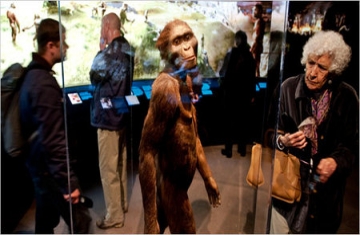
Above: Visitors looking at displays about the famous female
hominid at the “Lucy’s Legacy” exhibit at Seattle’s Pacific
Science Center, which failed to draw crowds.
NYT
By WILLIAM YARDLEY
Published: March 13, 2009
IT was not the expansive new mural depicting evolutionary history that brought Sandy McKean down to the Pacific Science Center on a rainy winter weekday. Nor had he come to linger over the elegant displays about Ethiopian culture. The reason Mr. McKean paid the $20.75 admission fee for “Lucy’s Legacy: The Hidden Treasures of Ethiopia” was because he wanted to see the bones. They are 3.2 million years old but, for him, electric with urgency. This was the first American exhibition tour of the famous Lucy fossils, 47 skeletal fragments of a female hominid whose discovery one day in 1974 altered the study of human history. Read more.
Related: Lucy’s fossil secretly scanned in Texas
UPI, Science News
AUSTIN, Texas, Feb. 6 (UPI) — Archaeologists at the University of Texas at Austin were given a top secret look at Lucy, one of the world’s most famous fossils. The 3.2 million-year-old hominid skeleton, found in Ethiopia in 1974, made a 10-day stop at UTA’s High-Resolution X-ray Computed Tomography Facility in September after an eight-month exhibit at the Houston Museum of Natural Sciences. With guards standing close watch, UT scientists were allowed to make 35,000 computed tomography images of the ancient fossil. While U.S. researchers conducted a scan on the fossil in the 1970s, the new scans provide the first high-resolution data on the early human ancestor, the Austin (Texas) American-Statesman newspaper said Friday. Read more.

























